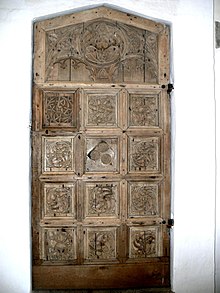Iver Munk
Iver Munk (* around 1470; † February 9, 1539 in Ribe ) was the last Roman Catholic bishop of Ribe before the Reformation .
Life
Iver Munk came from the Danish noble family Munk from Jutland . His father was Oluf Munk zu Krogsgaard (near Viborg ) and Kleitrup, his mother Ide Iversdatter Juel zu Daubjerggård. This branch of the family was related to the Jutian noble Lange family and had three roses in the coat of arms, which, together with that of his mother, can also be found on his grave slab. His brother was the Danish Imperial Councilor Mogens Olufsen Munk († 1558), ancestor of Kirsten Munk , and Christian IV's wife since 1615 .
Munk studied at the Universitas Studii Coloniensis in 1489 and from 1490 at the University of Greifswald and completed his studies in 1494 as a bachelor's degree in canon law . From 1498 he is also known as a Magister. He was initially a priest and canon in Ribe and in 1499, succeeding his uncle Hartvig Juel († 1500), he became the last Roman Catholic bishop in the diocese of Ribe . It is said that it was not consecrated until fourteen years later . As a bishop, he primarily protected his relatives. Although obliged to be celibate , he had two sons, Frands († April 27, 1567) and Niels Iversen Munk († after 1580), whom he recognized and also generously supported with Ide Frandsdatter Pogwisch .
Like his brother, he was one of the ringleaders of the uprising of the Danish clergy and Danish nobles against King Christian II in 1522/23 , who opened up to Reformation ideas early on and had passed laws directed against the clergy in 1521. But the new King Frederick I disappointed the hopes of the rebels by more or less openly supporting the Reformation. Ivar Munk, on the other hand, prohibited Lutheran sermons in his diocese. Munk is one of those who, after Frederick's death in 1533, voted for his son, the future King Christian III. refused and thus gave rise to the count feud .
Ivar Munk served as bishop until 1534, when he handed over his office to his nephew and future successor, Olaf Munk. Olaf Munk ran the official business until 1536, but then had to give up the office of bishop in the course of the Reformation after the resignation of Archbishop von Lund Torbern Bille . Ivar Munk was arrested like the other Danish bishops, but was soon released. After giving up office and property, he was allowed to continue living in the bishop's palace, where he died in 1539. His successor was the first Protestant Bishop of Ribe, Magister Johann Wenth , who carried out the Reformation in Jutland and North Schleswig together with Eberhard Weidensee from Hadersleben .
Ivar Munk's grave plate in Ribe Cathedral is Clausberg in Odense attributed and was already in 1530, before Munks resignation and death, made. The coats of arms are of men savages kept as similar - if somewhat more peaceful - even the coat of arms of Danish kings show. Munk also donated the preserved Gothic bishop's door and the existing choir stalls to the Ribe Cathedral.
See also
literature
- Mikael Venge: Iver Munk in Dansk Biografisk Leksikon , 3rd edition from 1979-84
Web links
Individual evidence
- ↑ Genealogy at finnholbek.dk
- ↑ Genealogy with coat of arms at gravstenogepitafier.dk
- ↑ Genealogy
- ^ Waldemar Kawerau: Weidensee, Eberhard . In: Allgemeine Deutsche Biographie (ADB). Volume 41, Duncker & Humblot, Leipzig 1896, pp. 448-450.
- ↑ Enno Bünz, Klaus-Joachim Lorenzen-Schmidt: Clergy, Church and Piety in Late Medieval Schleswig-Holstein , Wachholtz, Neumünster 2006, p. 167
| personal data | |
|---|---|
| SURNAME | Munk, Iver |
| BRIEF DESCRIPTION | Bishop of Ribe |
| DATE OF BIRTH | around 1470 |
| DATE OF DEATH | February 9, 1539 |
| Place of death | Ribe |


